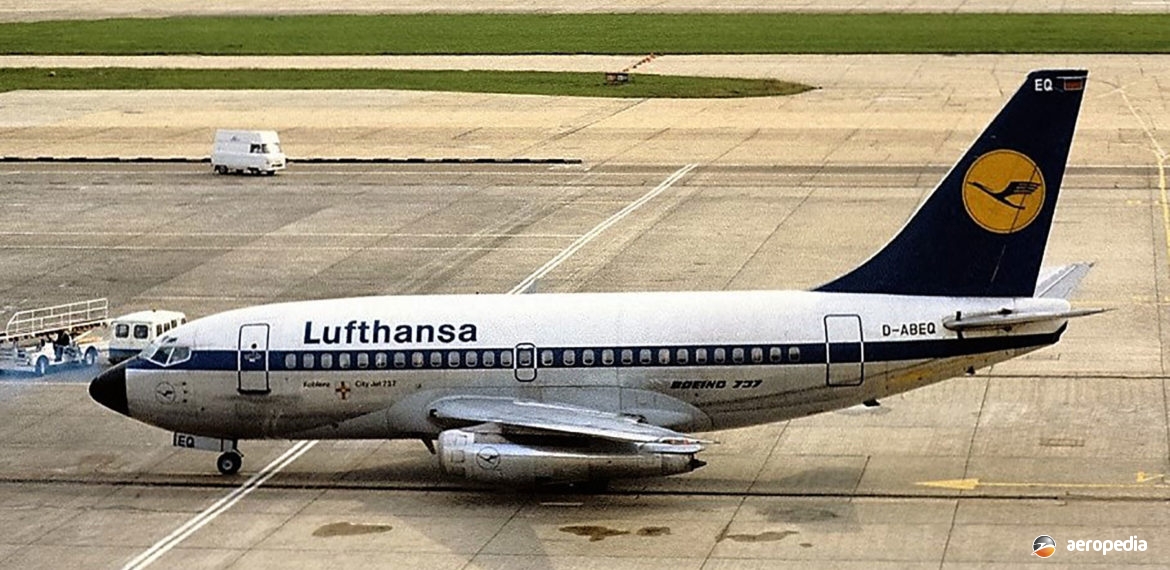Photograph:
Boeing 737-130 D-ABEQ (c/n 19027) operated by Lufthansa in Europe (David C Eyre)
Country of origin:
United States of America
Description:
Commercial airliner
Power Plant:
Two 14,000 lbst Pratt & Whitney JT8D turbofans
Specifications:
- Wingspan: 28.35 m (93 ft)
- Length: 28.65 m (94 ft)
- Height: 11.23 m (36 ft 8 in)
- Wing area: 102 m² (1,098 sq ft)
- Max speed: 933 km/h (580 mph)
- Max Mach: 0.82
- Service ceiling: 10,668 m (35,000 ft)
- Range: 3,185 km (1,979 miles)
- Empty weight: 28,120 kg (61,994 lb)
- Loaded weight: 49,896 kg (110,000 lb)
History:
The Boeing 737 series was designed for the world’s short-to-medium airliner market and was a two-engine narrow-body aircraft, making its first flight in April 1967. It was derived from the success of the Boeing Model 707 and Model 727, and in due course was developed into a family of passenger aircraft with a capacity ranging from 85 to 215 passengers. Boeing announced it was consideringt developing the series in 1964 but the initial 737-100 series did not appear until 1967 and entered airline service in February 1968 with German airline Lufthansa.
The initial variant, the 737-100, was 94 ft (28.65 m) long, carried 115 passengers and had an MTOW of just 42,411 kg (93,500 lb), less than half that of the later Model 737-900 series. The original choice of powerplant was the Pratt & Whitney JT8D-1 at 14,000 lbst, but by the time negotiations with the launch customer, Lufthansa, were concluded it had been decided the JT8D-7 was to be installed. This engine was flat-rated to develop the same thrust at higher ambient temperatures than the JT8D-1 and became the standard powerplant for the 737-100 series.
Only 30 examples of the series 100 were built, with 22 going to Lufthansa, five to Malaysia Airlines and two to Avianca. The last airworthy Model 737-100 (L/N 3), which first flew on 12 June 1967, was finally retired from Aero Continente service in Peru as OB-1745 in 2005.
Four examples of the 737-100 series were imported and operated in New Zealand. These were ZK-NEA, a Model 737-130 (c/n 19013 – ex N701AW, D-ABEA, N2282C) first registered to National Airways Corporation in May 1987, eventually being struck from the register in April 1991 and becoming N701PJ, being scrapped at Marana in October 1995. The second became ZK-NEB, a Model 737-130 (c/n 19015 – ex N702AW, D-ABEC, N2289C) first registered in July 1987, exported in April 1991 as N702PJ, and eventually scrapped at Marana in November 1995.
ZK-NEC was also a Model 737-130 (c/n 19016 – ex N703AS, YV-406C, D-ABED) registered in May 1987 and exported as N703PJ in June 1991, being scrapped at Tucson, Arizona in January 2001. ZK-NED was a Model 737-112 (c/n 19770 – ex N709AW, N42AF, 9V-BFE, 9M-AOV) registered in July 1987 and exported as N73GQ in April 1990, being scrapped in 1995.
Ansett World Wide Aviation Services contracted to lease six Model 737-300s to American West Airlines, and obtained four of that airline’s old Model 737-100s, the latter to be used by Newmans in New Zealand, operating on domestic services by Ansett New Zealand. These were ZK-NEA (c/n 19013), ZK-NEB (c/n 19105), ZK-NEC (c/n 19016), all Model 737-130s; ZK-NED (c/n 19770), a Model 737-112; ZK-NEE (c/n 20195), a Model 737-2A6 and ZK-NEF (c/n 22575), a Model 737-2U9.
The Boeing 737 series has been very successful and by March 2018 the 10,000th example had been delivered and production continued.

